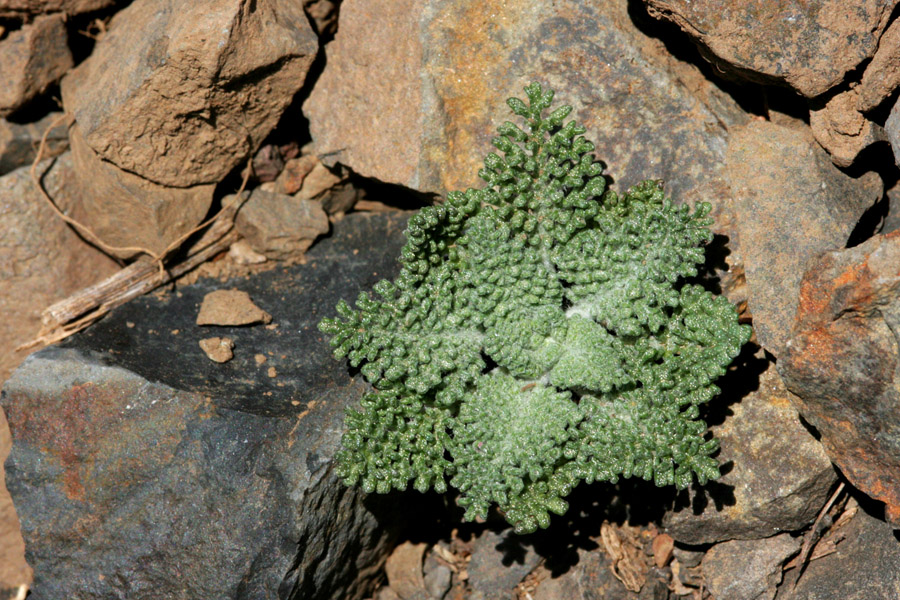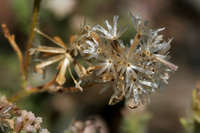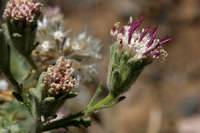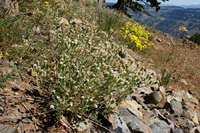- Home
- Search
- Images
- Datasets
- Sample Use
- How to Cite
- Additional Information
- About NEON
- NEON Data Portal
- ASU Biocollections
- About Symbiota
|
|
|
|
Family: Asteraceae
Douglas' dustymaiden
[Chaenactis angustifolia Greene, moreChaenactis brachiata Greene, Chaenactis douglasii var. achilleifolia (Hook. & Arn.) A.Gray, Chaenactis douglasii var. glandulosa Cronquist, Chaenactis douglasii var. montana M.E.Jones, Chaenactis douglasii var. nana Stockw., Chaenactis douglasii var. rubricaulis (Rydb.) Ferris, Chaenactis humilis Rydb., Chaenactis ramosa Stockw., Chaenactis rubricaulis Rydb., Chaenactis suksdorfii (Gand.) Stockwell, Hymenopappus carolinensis (Lam.) Porter] |
Biennials or perennials, (2-)5-50(-60) cm (rarely slightly woody or flowering first year, sometimes cespitose or ± matted); proximal indument thinning with age, grayish, mostly arachnoid-sericeous to thinly lanuginose. Stems 1-25+, erect to spreading. Leaves basal, or basal (sometimes withering) and ± cauline, (1-)2-12(-15) cm; largest blades ± elliptic or slightly lanceolate to ovate, ± 3-dimensional, usually 2-pinnately lobed; primary lobes (4-)5-9(-12) pairs, ± congested, scarcely imbricate, ultimate lobes ± involute and/or twisted. Heads 1-25+ per stem. Peduncles mostly ascending to erect, 1-10 cm. Involucres obconic to ± hemispheric. Phyllaries: longest 9-15(-17) mm; outer usually stipitate-glandular (sometimes sparsely or obscurely, rarely eglandular) and, often, arachnoid to lanuginose and, sometimes, sparsely villous, apices usually ± squarrose, pliant. Corollas 5-8 mm. Cypselae 5-8 mm (usually sparsely glandular amidst other indument); pappi: longest scales 3-6 mm. Chaenactis douglasii is widespread and variable (see discussion under var. douglasii).
FNA 2006, Kearney and Peebles 1969, Jepson 1993 Duration: Perennial Nativity: Native Lifeform: Forb/Herb General: Erect to spreading biennial to perennial herbs to 60 or more cm tall, sometimes silghtly woody at the base or matted, herbage grayish, bearing long, cobwebby, tangled hairs, sometimes downy or wooly. Leaves: Alternate, basal and cauline, elliptic to ovate, usually pinnately lobed 2 times, primary lobes 5-9, somewhat 3-dimensional and succulent, ultimate lobes somewhat involute or twisted. Flowers: Heads discoid, disks flesh colored or white, corollas 5-8 mm, 1-25 or more per stem, involucres obconic to hemispheric, phyllaries granular-glandular and villous, the longest 9-15 mm, the outer gland-dotted, apices reddish, acuminate with awn-like tips, erect. Fruits: Achenes linear, 5-8 mm. Pappus of hyaline paleae, these without a midrib. Ecology: Found in dry areas in disturbed areas, alpine crevices, and open pine forest from 3,500-11,500 ft (1067-3505 m). Distribution: Widespread across the United States, from Alberta and British Columbia, south to Arizona, California, New Mexico, and Utah. Ethnobotany: The mashed plants were rubbed on limbs for sore muscles and aching, an infusion of the whole plant was given to children to slow racing heartbeats, for indigestion, colds and coughs, and used externally to soothe sores, acne, chapped hands, boils, tumors, and swellings, to treat insect and snake bites, for headaches, and a decoction of the roots was taken by the families of a deceased person to avoid consumption and sickness, and used as an eyewash. Etymology: Chaenactis is from the Greek chaino, to gape and aktis, ray, referring to the enlarged corollas, while douglasii is named for David Douglas (1798-1834), a Scottish plant collector. Synonyms: Hymenopappus douglasii, Macrocarphus douglasii Editor: LCrumbacher 2011 |





